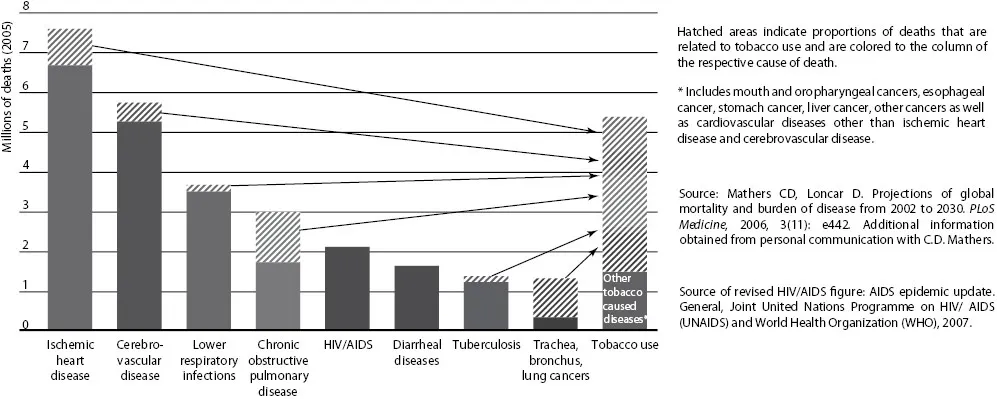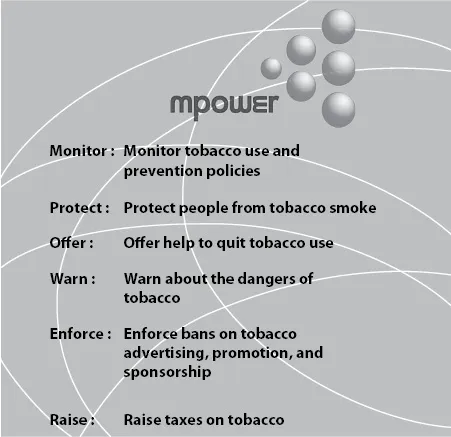
eBook - ePub
Tobacco Cessation
A Practice Manual for Primary Care Physicians
Rajmohan Panda, Manu Raj Mathur, Rajmohan Panda, Manu Raj Mathur
This is a test
Share book
- 18 pages
- English
- ePUB (mobile friendly)
- Available on iOS & Android
eBook - ePub
Tobacco Cessation
A Practice Manual for Primary Care Physicians
Rajmohan Panda, Manu Raj Mathur, Rajmohan Panda, Manu Raj Mathur
Book details
Book preview
Table of contents
Citations
About This Book
Cessation of tobacco use is the need of the hour given that it is the single largest cause of disease and premature death in the world. This book covers epidemiology and risks, user classification, nicotine replacement therapy, pharmacological aids, behavioral modification and patient counseling techniques, along with personalized action plan development.
Key Features
-
- Covers all aspect of tobacco cessation.
-
- Provides guidance on differential diagnosis and includes useful decision-making flowcharts.
-
- Provides step-by-step guidance to counsel tobacco users in routine clinical practice.
-
- Discusses the process of setting up a cessation centre.
-
- Facilitates in-depth understanding of the subject through case studies at the end of each chapter
Frequently asked questions
How do I cancel my subscription?
Can/how do I download books?
At the moment all of our mobile-responsive ePub books are available to download via the app. Most of our PDFs are also available to download and we're working on making the final remaining ones downloadable now. Learn more here.
What is the difference between the pricing plans?
Both plans give you full access to the library and all of Perlego’s features. The only differences are the price and subscription period: With the annual plan you’ll save around 30% compared to 12 months on the monthly plan.
What is Perlego?
We are an online textbook subscription service, where you can get access to an entire online library for less than the price of a single book per month. With over 1 million books across 1000+ topics, we’ve got you covered! Learn more here.
Do you support text-to-speech?
Look out for the read-aloud symbol on your next book to see if you can listen to it. The read-aloud tool reads text aloud for you, highlighting the text as it is being read. You can pause it, speed it up and slow it down. Learn more here.
Is Tobacco Cessation an online PDF/ePUB?
Yes, you can access Tobacco Cessation by Rajmohan Panda, Manu Raj Mathur, Rajmohan Panda, Manu Raj Mathur in PDF and/or ePUB format, as well as other popular books in Medicine & Medical Theory, Practice & Reference. We have over one million books available in our catalogue for you to explore.
Information
Chapter 1
Introduction
Manu Raj Mathur
Objectives
The major objectives are to
•Learn about the burden of different forms of tobacco use
•Understand the importance of tobacco cessation and role of physicians
Skill Sets You Will Acquire
You will be able to conceptualize
•The burden of tobacco use in India
•The importance of tobacco cessation services in India
•The role of health care professionals in tobacco cessation
Background
In India, every third adult consumes tobacco* which is an established major risk factor for noncommunicable diseases (NCDs), leading to one million smoking-related deaths per annum. The death burden is expected to rise in low- and middle-income countries, like India, due to the current pattern and alarming rise in tobacco use.1,2 There are 275 million tobacco users (111 million smokers) in India that mostly affect the vulnerable lower socioeconomic and rural populations (Figure 1.1).3

Figure 1.1 Tobacco use is a risk factor for six of the eight leading causes of death in the world. (From WHO Report on Global Tobacco Epidemic, 2008.)
Tobacco use is classified under mental and behavioral disorders in accordance with the International Classification of Diseases (ICD-10).4 Around 53% current smokers in India have either no interest in quitting or are undecided about their intention to quit. A slightly higher proportion (55%) of current tobacco users report no intention to quit. This clearly signals the need to fully utilize a range of cost-effective tobacco control approaches such as legislation, education, and cessation. A comprehensive tobacco control approach (Figure 1.2) will help reduce smoking prevalence and the associated morbidity and mortality in the long term. But, among these, tobacco cessation interventions will reap health benefits in the short term, leading to a reduction in near-term tobacco-related mortality and morbidity,5–7 whereas others would take two to three decades.

Figure 1.2 MPOWER measures introduced by WHO.
Health care professionals have a role to play in all aspects of tobacco control, but their position naturally lends itself to “W,” to warn about the dangers of tobacco, and, “O,” to offer help to quit.8
Since 2001, only 19 public tobacco cessation centers have been established in India.9,10 Their establishment within the tertiary care health facilities gave only a limited access to tobacco users, particularly to those living in rural areas. They were also poorly accessed by youth.11 These centers, therefore, could serve only 34,741 tobacco users during the first 5 years; a small fraction of tobacco users who made an attempt to quit.11 The available manpower in these centers was also inadequate to serve the population of 20–40 lakhs (2–4 million). It is critical, therefore, to address the need for socially vulnerable groups with limited access to cessation service utilization by establishing countrywide tobacco treatment facilities. In a way, India is already late in making its provision at the level of primary care, as has been recommended by the WHO, with reference to the availability of quitlines.12
According to the GATS India survey, about two out of five current tobacco users (smokers: 38%, tobacco chewers: 35%) have attempted to quit in the past 12-month period. In 2010, among smokers, 9% used counseling and another 4% used pharmacotherapy for cessation. In users of smokeless tobacco, 8% used counseling to quit and another 22% used other methods. These facts indicate an ample opportunity to explore ways to improve the demand for tobacco cessation services in India.
The GATS India survey also reports that the overall participation of health care professionals (HCPs)—to ask and assist tobacco users to quit is quite low. Of the total tobacco users visiting a health facility, only 46% smokers and 27% of smokeless tobacco users were asked by the HCPs to quit. The tobacco users who were further assisted to quit was even lower. This raises concern about the capability of HCPs to intervene with tobacco users. A system-wide approach to tobacco treatment, at various levels of health care would greatly assist HCPs. This has yet to be addressed.
Empowering doctors to provide behavioral counseling details for the skills (counseling) needed for tobacco treatment is a challenge. The behavioral change theories (e.g., plans, responses, impulses, motives, evaluations [PRIME]) and techniques12 are a cornerstone of tobacco cessation counseling and the application of these principles to tobacco cessation requires soft skills on motivating tobacco users to quit using tobacco. The traditional curriculum does not train HCPs in soft skills. Therefore, to deliver tobacco treatme...